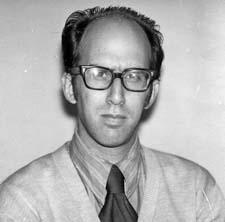
MSP 3800
(Nota del editor: una traducción al español de esta carta se encuentra aqui.)
This handwritten unsigned note recovered in Jonestown describes the community in death in eloquent, almost poetic terms. It was written in a small Guyana Exercise Book and extends over eight pages. The author is almost undoubtedly Richard Tropp, whose handwriting sample – uncovered by Denice Stephenson of San Francisco – is similar to the writing in the note.
There are other indications that Richard Tropp is the author. The writer is somewhat removed from what is going on at the pavilion, indicating a position of trust and leadership. The fact that the last line refers to “darkness” also suggests that the person was in the leadership group, most likely in Jim Jones’ cabin – where a group of up to 20 people was deciding who would leave Jonestown with a briefcase of money to give to the Soviet Embassy in Georgetown – after most of the murders/suicides had ended late that afternoon. The choice of words and writing style would indicate that the person is educated. The language indicates that the person saw Jonestown as a political refuge, as opposed to a religious commune or a utopian experiment.
Richard Tropp meets all of these criteria.
Aside from these observations, there is the conclusion of his partner, Kathy Tropp, who wrote in 2021 that she is “99% sure” it is Dick.
I have … decided it was definitely his writing. I’m convinced because it’s consistent with his thought process, his need to articulate for the entirety of the community, and also with whatever I have been able to put together of his movements that day. There is his pointed mention of the Oral Histories (his project) to which he directed the reader of the note, which ironically still are not available to the public. Additionally, it’s clear the writer knew nothing of Jim’s sending the “some ones” who fired on the Congressman’s plane, triggering the final assembly. And that he betrays his own inner torment at this path decreed (despite his vehement opposition, not mentioned in the Last Words) throughout the pages. How to convey the inexcusable? And finally, not signing his name. That is Dick all over, not wanting his father’s name, self-effacing to the max, but still identifying to the core with those he would soon join.
One Jonestown researcher asserts that the handwriting on the unsigned note matches that of Jones’ wife Marceline. While its tone is personal, almost intimate, yet it seems a step removed from a letter that Marceline might write; moreover, Marceline’s remains were found at the pavilion, not with those of the Jonestown leadership in Jones’ cabin.
The tone of the note is, as Kathy Tropp points out, “sincerely devoid of ‘macho’.” Other than Marceline, only a few women – Ann Moore, Carolyn Moore Layton, Maria Katsaris, and Richard’s sister Harriet Tropp – meet all the other criteria set out above, including being part of the Jonestown leadership group. Ann Moore was already writing a note, so it is probably not her. Maria Katsaris’ rhetoric was not known to be as overtly political as that of Carolyn Layton or Harriet Tropp. Certain sentences – “Jim Jones and this movement were born too soon” – are reminiscent of letters Carolyn wrote to her parents, such as one in which she described Peoples Temple as being born out of time; yet the handwriting is different. The same is true for the few samples of Harriet’s handwriting, so the authorship is not hers.
It should be noted that former Temple member Laurie Efrein Kahalas disagrees strongly with this analysis and argues that the author is Marceline Jones. Her article, Final Witness: The Legacy of Marceline Jones, was published in 2021.
Richard Tropp’s last letter, November 18, 1978, RYMUR 89-4286-X-1-a-54
PDF
Text
Spanish translation, by Luis Ángel González Rocha